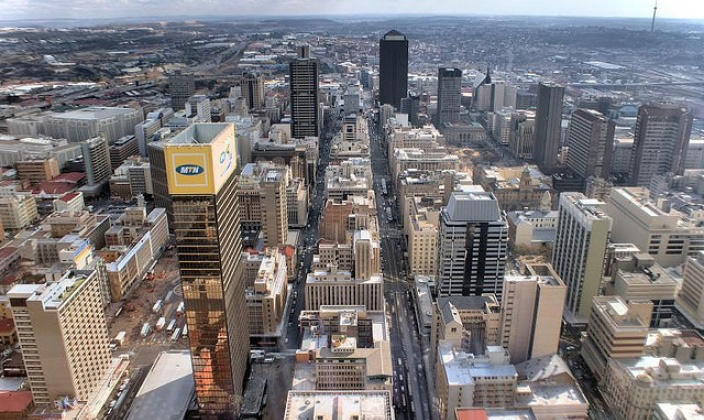Johannesburg: Profile of a Global City

Water is essential to human civilization. This is why nearly every major urban center is located near a significant body of water. Except one. Johannesburg is the largest city in the world NOT near a river, coast, or large lake. This metro area of more than ten million must import water from the nearby nation of Lesotho.[1]This is only one of the many intriguing details that make up Johannesburg.
The city is relatively young, growing from a rural farm community to a boomtown after gold was discovered in 1884. The discovery of gold meant a rapid increase in infrastructure, technology and laborers. Within ten years, a stock exchange was established in Johannesburg, which has made it the key financial center in the country and even the continent.[2]As such, Johannesburg has become a business leader in the region and has drawn a diverse international community as a result.
The city boasts many different cultures and over three hundred languages. While there have been languages used within ethnic enclaves and other languages that are used as trade languages, Johannesburg residents have forged an “urban vernacular” called Iscamtho, developed in the township of Soweto.[3]The diversity of people has led to a vibrant range of eateries, coffee shops and the arts, moving the city from mere financial hub to a key producer of culture.
All cities have glaring issues of injustice and Johannesburg is no exception. The rich resource in gold that became a source of wealth for the city also became a source of greed and inequality that would cast a deep shadow over the city. Policies of apartheid fostered intense inequality along racial lines. Even the spatial arrangement of the city highlights inequalities. There is a north-south divide in the city, with the poor living on the southside and the wealthy on the northside.[4]Due to a thriving economy, migrants and refugees have sought a better life in the city. Some estimates suggest two million migrants from other nations in Africa.[5]This has led to not only economic inequalities, but ethnic tensions, particularly towards perceived outsiders.[6]
Johannesburg is a spiritual city. This spirituality is reflected in more overt and institutionalized religion as well as in the many informal spiritual practices inherited from the different cultural legacies conglomerated in the city. There are glimpses of the church taking action to engage this city of great need and great opportunity. For example, the Central Methodist Church rejected the common xenophobia and provided a home for Zimbabwean refugees.[7] In a second example, the Door of Hope took in abandoned babies and raising them. In the Mission City podcast interview, Kurt Holiday shares about his experiences working in Johannesburg. He loves the city and sees incredible potential for the church in the city to make a difference there and far beyond its borders.
______________________________
[1] This includes Greater Johannesburg Metropolitan Region or Gauteng City Region, including Tshwane (formerly Pretoria), and cities in the East and West Rand and Vaal area. Jacqueline Borel-Saladin, “Where to Draw the Line: Data Problems and Other Difficulties Estimating Urbanisation in Africa,” Development Southern Africa 34, no. 2 (2017): 140; Greg Clark, Global Cities: A Short History(Washington, D.C.: Brookings Institution Press, 2016), 172.
[2] Johannesburg leads all African cities in global city rankings as an Alpha city. Myers shows the rise of African cities in global connectivity during recent years. Garth Myers, “The Africa Problem of Global Urban Theory: Re-Conceptualising Planetary Urbanisation,” in African Cities and the Development Conundrum, ed. Carole Ammann and Till Förster, vol. 10 (Brill, 2018), 233, https://www.jstor.org/stable/
[3] Rose Marie Beck, “Urban Languages in Africa,” Africa Spectrum 45, no. 3 (2010): 32.
[4] Peter Ahmad and Herman Pienaar, “Tracking Changes in the Urban Built Environment:: An Emerging Perspective from the City of Johannesburg,” in Changing Space, Changing City, ed. Philip Harrison et al., Johannesburg after Apartheid – Open Access Selection (Johannesburg: Wits University Press, 2014), 102.
[5] Tayob notes the migrants came after apartheid was lifted in 2004. Soon racial inequality was exchanged with migrant inequality. Huda Tayob, “Black Markets: Opaque Sites of Refuge in Cape Town,” in Refuge in a Moving World: Tracing Refugee and Migrant Journeys Across Disciplines, ed. Elena Fiddian-Qasmiyeh (London: UCL Press, 2020), 349.
[6] Geneviève James, “Urban Theology Endeavours and a Theological Vision of Hope and Justice for Post-Apartheid South African Cities,” Stellenbosch Theological Journal 1, no. 2 (2015): 44.
[7] Piet Naudé, “African Urbanisms: Reinterpreting the Marks of the Church,” Stellenbosch Theological Journal, no. 2 (2015): 78.
